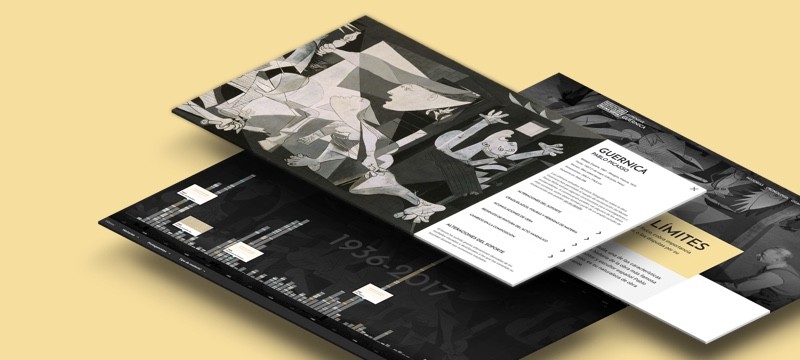To approach the scope and influence of Guernica, and its inseparable artistic and political value, the mere physical presence of the work must be transcended. That is, as part of its history, there must be a deliberation on the rejected requests of museums, and the replicas, artistic appropriations and sporadic uses of the work as a symbol of protest.
The painting charts an intercontinental map, revealing a system of relations enhanced and intensified over time.
On one side, the journeys Guernica undertook demonstrate its capacity to adapt and transform its symbolic value, and on the other, the use of the image beyond a museum setting underscores its undeniable quality as a timeless allegory outside questions of ownership.
One aspect characterising the history of the foremost work by Spanish artist Pablo Picasso is its quality as a travelling artwork.

Painting's travels
Before being hung in the Museo Reina Sofía in Madrid, in July 1992 Guernica had been on display in different cities across eleven countries in Europe and the Americas, where it became the centrepiece of exhibitions and part of the memory of a newly constructed world order. Yet Guernica’s increasingly symbolic value, beyond the use made by exhibitions housed in museums and institutions, charts a much broader geography, where its image, so often transformed and adapted, synthesises political and artistic accounts of highly divergent contexts.
Failed travels
This geography encompasses the journeys made by the painting, as well as the loan requests rejected for political reasons, or over security or conservation concerns. Therefore, Guernica sheds light on the anonymous and institutional hopes and aspirations surrounding it, and the occasions in which, in the original work’s absence, it has been replicated or translated into other mediums, supports and scales.
Guernica as an image
The limits of this map are transcended when the work is appropriated by spheres of protest and resistance, its iconic value and quality as an anti-war symbol and allegory transporting it to neighbourhoods, streets, prisons, and social initiatives on every continent, where it is fully or partially reproduced on posters, placards, stickers, leaflets, and walls. Furthermore, artists from different countries also participate in this geographic expansion, through the versions, updates and adaptations of Guernica on different supports, at times fusing it with non-Western aesthetics and employing a renewed iconography which is idiosyncratic of different places and the reasons for its emergence. In joining together every geographical point, Guernica sketches the possibility of a borderless geography. In its quality as an icon which comes into view with the threat of violence against civilians, where individual or collective freedom are under threat, and in its identification with bombings, Guernica as an image evinces the places where war and violence re-occur.












![Demonstration against the Iraq War [Manifestación contra la guerra de Iraq] Demonstration against the Iraq War [Manifestación contra la guerra de Iraq]](/sites/default/files/styles/medium/public/documento/GUE-1656.jpg?itok=g3pTjWrU)


